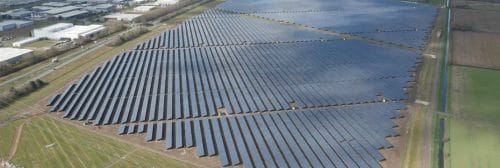 By Legal Futures’ Associate Future Climate Info
By Legal Futures’ Associate Future Climate Info
Summer is here – the sun is shining! And it seems brighter and hotter each year. As the climate changes, we need to adapt and harness this energy to create more resilient supply. Is solar energy the answer? We examine the potential and the issues that come with it.
By 2025 the Government are planning to close all coal power stations, recognising that it must play its part in greenhouse gas reductions, which are having a disastrous impact on our planet.
The UK while probably likely to fail on its 2020 carbon targets, it is catching up well on renewable energy production, hitting 33% of all energy produced last year.
As of 2019, installed solar capacity was over 13 Gigawatts (GW), with peak generation less than 10GW. This equates to somewhat lessthan 5% of UK electricity consumption. However, at certain times of the day, it can contribute up to a third of the energy needed.

Shotwick solar park
Why Solar Energy?
With warmer, sunnier days, especially in the south and east, solar energy farms could be the answer for a large part of the population.
According to the International Energy Agency, solar power was the fastest-growing source of new energy worldwide last year, overtaking the growth in all other forms of power generation for the first time.
There is an abundant supply of electricity generation potential from the sun, using increasingly cheaper technology. We need to build resilience to the National Grid as it faces future high demand from electric vehicle growth.
We have the ability to use solar to meet our needs, and become more self-reliant, especially when harnessed alongside wind energy for all-weather supply.
Large solar farms can be built in just a few months – compared to several years for a coal plant and even longer for a nuclear plant – without generating potentially massive environmental and health issues. The land used for solar farms creates a place where nature and wildlife can flourish, as the ground beneath the solar panels can be used to graze animals or grow crops.
Solar needs Space
To get planning approval for a solar farm, rigorous conditions must be passed. Developers must account for the site suitability (will it benefit from harnessing sunlight?), the impact on locality (will it affect the local environment, economy and ecology?), as well as meeting the relevant energy target.
Because of the large land take, they are usually developed in rural areas. Approximately 25 acres of land is required for every 5 megawatts of installation. Based on the average annual energy consumption of a household, for every 5MW installed, a solar farm will power approximately 1,500 homes for a year.
As panels have a capacity factor of around 10% in the variable UK climate, average annual generation is roughly the installed capacity multiplied by 1000 hours, being slightly under 13 Terawatt Hours (TWh) in 2018. Given the variable nature of the UK’s weather they have to be large to meet the necessary efficiency gains.
And this means the need to use thousands of panels. The 72MW Shotwick Solar Farm in Flintshire is the largest in the UK. Commissioned in 2016, it was built in just 6 weeks. The site is connected directly to the private infrastructure of the UK’s largest paper mill, offsetting roughly one third of their annual electricity demand & making it the largest private wire solar park in Europe.
Chapel Lane solar farm in Dorset is another large site and is now meeting the electricity needs of 60,000 homes in Bournemouth on a summer’s day.
Community, Wildlife and Food Production Concerns
Solar has been met with mixed feelings by local authorities and communities. Public perception has leant towards them being unattractive, although given the choice between that and a 20 metres tall wind turbine near their village that view may change.
There are concerns that the profusion of electrical infrastructure can have an impact on the wildlife that are displaced, but there are few conclusive studies of this as of yet and solar installations may be no worse than any other installation, like pylons or substations.
There are also concerns that solar farms are taking up agricultural land that would otherwise be used to support our food supply and security. Based on need, however it is estimated by the UK solar industry that less than 5% of typical farmland plots would be taken up by solar infrastructure, leaving the vast majority for other uses.
Just to be sure, though, the Government has put a brake on this, cutting subsidies to farmers for solar farms in an effort to curb the rapid expansion – potentially counter-intuitive to the drive for renewables, you could say.
There is a solid counter-argument that solar/battery farms (and onshore wind) could be the answer to protecting and stabilising farm income. Periods of drought and severe surface flooding from individual weather events have affected traditional cropping periods and yields in many areas in recent years.
Local Authority Solar Purchasing Energy Growth
One of the growth areas in solar energy purchasing growth has come from Local Authorities. Faced with austerity-driven budget cuts, they are motivated to reduce energy costs, a significant part of their operating overhead.
Warrington Borough Council has agreed to buy two cutting-edge solar farms to be built in Yorkshire, making it the first local authority to produce all of its own electricity from clean sources.
A 25.7MW solar farm in Hull will supply 100 per cent of the council’s electricity needs and cut its energy bills by up to £2 million a year. Electricity from a 34.7MW hybrid solar farm and 27MW battery storage system near York will also be initially sold on the open market.
Together the two solar farms will generate enough power to supply the equivalent of more than 18,000 homes . Both sites will also feature electric forecourts once they are up and running, offering supercharging services for up to 24 electric vehicles simultaneously.
Cllr Russ Bowden, leader of Warrington Borough Council, believes it will “generate an estimated operating surplus of £150 million over 30 years that can be invested back into the most important frontline services.”
Future Prospects for Solar
These large scale installations are the focus of sector growth as far as the planning pipeline is concerned. According to Solar Media Market Research, there are some 400 sites identified and some 131 with a realistic prospect of being approved. Investment decisions are in part stalled by Brexit for some locations.
There is a notable shift by fossil fuel firms, like Shell and BP to reposition their brands towards the acquisition of clean energy. Shell has, for example, become the largest reseller of energy from the the 69.8MWp Bradenstoke solar power plant.
There is also reduced interest in solar PV installs on individual domestic property since the closure of the Feed-in Tariff in March of this year.
Keeping track with changes
With property purchase decisions now often made for 20-30 years hence, homebuyers must consider how the local area’s energy needs and changes could affect their habitat.
Future Climate Info provides conveyancers and their clients with the latest insight on energy and infrastructure changes that may affect the vicinity of a property.
As new schemes come online through planning, our Premium Environmental Report captures and alerts these in a clear and concise way so you can make an informed decision on whether your client’s investment could be harmed or improved.
Call us on 01732 755 180 or email info@futureclimateinfo.com












